Ensuring safety in our railway business and other businesses
Initiative guidelines
Based on the belief that safety and security are the backbone of our Group’s businesses, we will strive to improve customer satisfaction through measures to address stakeholder expectations, including planned investment in safety and conducting safety education and BCP training. Going forward, we will also strategically proceed with our response to natural disasters, which are expected to become even more severe.
Ensuring safety in our railway business and other businesses
Safety management in the railway business
Establishment of a Safety Policy, along with a system for business activities that has safety as its highest priority
On October 1, 2006, we established a Safety Policy*1 and are striving to develop a system for business activities based on the principle of holding safety as the top priority. Furthermore, we strive to ensure transportation safety through how we utilize our railway facilities,railroad cars, and employees.
Safety Policy
1.We will work together to prevent accidents, with safety as our top priority.2.We comply with all laws and regulations related to transportation safety and perform our duties in a strict and dedicated manner.
3.All necessary confirmations will be performed and the handling method that is considered to be the safest will be conducted within the course of our work.
4.In the event of an accident or disaster, we will accomplish with saving lives as the top priority, and swiftly take safe and appropriate measures.
5.We will operate our safety management system appropriately and make efforts for constant improvement.
Establishment of a safety management system led by the President
We endeavor to “promote the attitude of safety first” and “cultivate a culture of safety” throughout the company, mainly through the regularly scheduled meetings of the Safety Promotion Committee (headed by the President) and the monthly Safety Promotion Executive Committee (headed by the Comprehensive Safety Administration Manager). The heads of business management divisions for corporate strategies, financial strategies, and general administration & human resources also participate in the Safety Promotion Committee.
As the chief executive responsible for safety management systems,
the President appoints the Railway Business Division General Manager
as the Comprehensive Safety Administration Manager, and the Railway Business & Train Stock Department Chief Manager as the Transportation Manager, establishing a safety management system by clarifying the roles to be played by those responsible for each relevant department.
The “Safety Planning & Management Department” has been established as a department dedicated towards thoroughly ensuring safety and security. The Safety Planning & Management Department oversees matters related to the appropriate operation and improvement of safety management systems, and coordinates with relevant departments to promote organization-wide efforts that are necessary for improving the safety and stability of transport.
Committee organization

Safety management methods
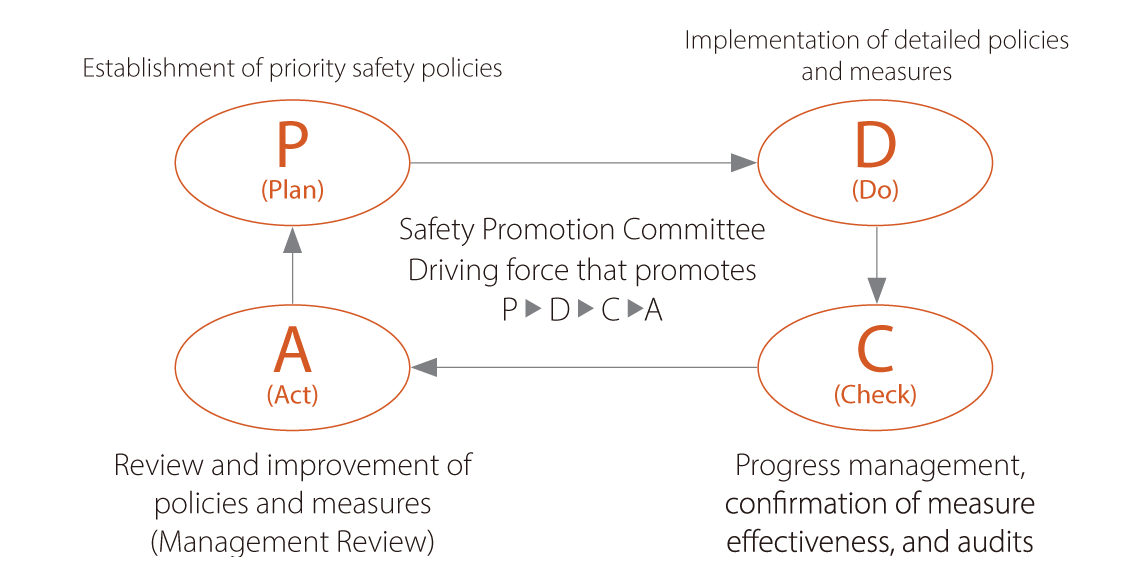
Structure of the Safety Promotion Committee
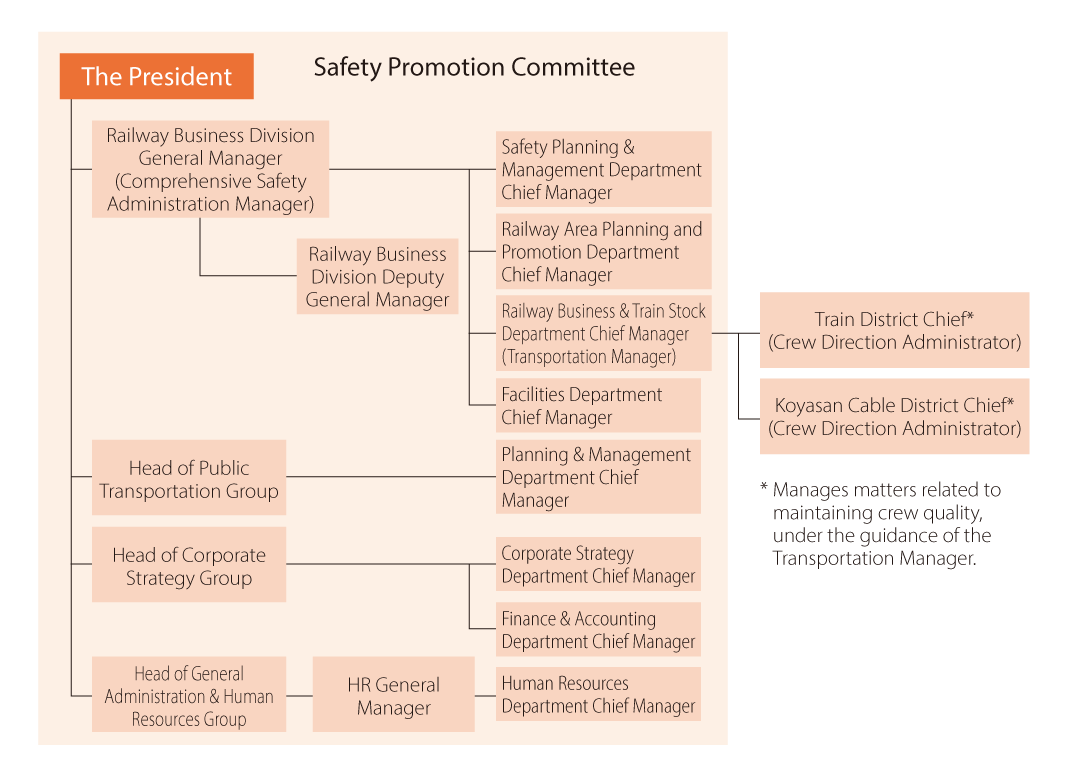
Transport safety management evaluation
In transport safety management evaluation, transport security inspectors working under the Director of Transport Safety of the Ministry of Land, Infrastructure, Transport and Tourism, and evaluation officers from local Transport Bureaus check our safety management status by interviewing our management, comprehensive safety administration managers, transportation managers, and other representatives of our business management division on our safety management system. The 8th transport safety management evaluation was conducted in September 2021 with no issues raised.Note that no transport safety management assessment was carried out in 2023.
Priority safety policies
To resolve issues and ensure transport safety, we have established and worked on the following five items as key safety measures for FY2024.
Under our safety management system, we have also conducted management reviews based on the status of key safety measures and results from internal safety audits.
Priority safety policies for FY2024
1.Reduction of the increasing risk of natural disasters and reinforcement of crime prevention measures2.Prevention of serious accidents through facility improvements (including social requirements), and improving safety at station platforms
and railroad crossings
3.Improving security through the renewal of train cars and facilities
4.Introduction and promotion of safety equipment systems using digital technologies
5.Cultivating human resources and passing down skills to support safety Prevention of human error
Investments for safety
Continued capital investment for safety measures
We continue to invest capital to systematically and promptly implement necessary safety measures.
Construction work was undertaken for seismic reinforcement of elevated bridge columns and station buildings to prepare for large earthquakes that are predicted to occur in the future, along
with measures to improve safety on station platforms and renewal of aging facilities.
We will continue to make investments for the systematic promotion of safety measures in FY2024 as well.
Major capital investments in 2023
Continuous overpass construction project
New 8300-Series (10th style) train cars
Seismic reinforcement of elevated bridge columns (Progress rate: 95.5%)
Disaster prevention measures (Kinokawa River Bridge scour prevention
measures, etc. on the Koya Line)
Installation of platform doors (Nakamozu Station, Platform 4)
Renewal of the platform lighting system and maintenance of emergency exit lights
Renewal of the flat-type railroad crossing obstacle detection device and
maintenance of railroad crossing obstruction warning devices
Investments for safety
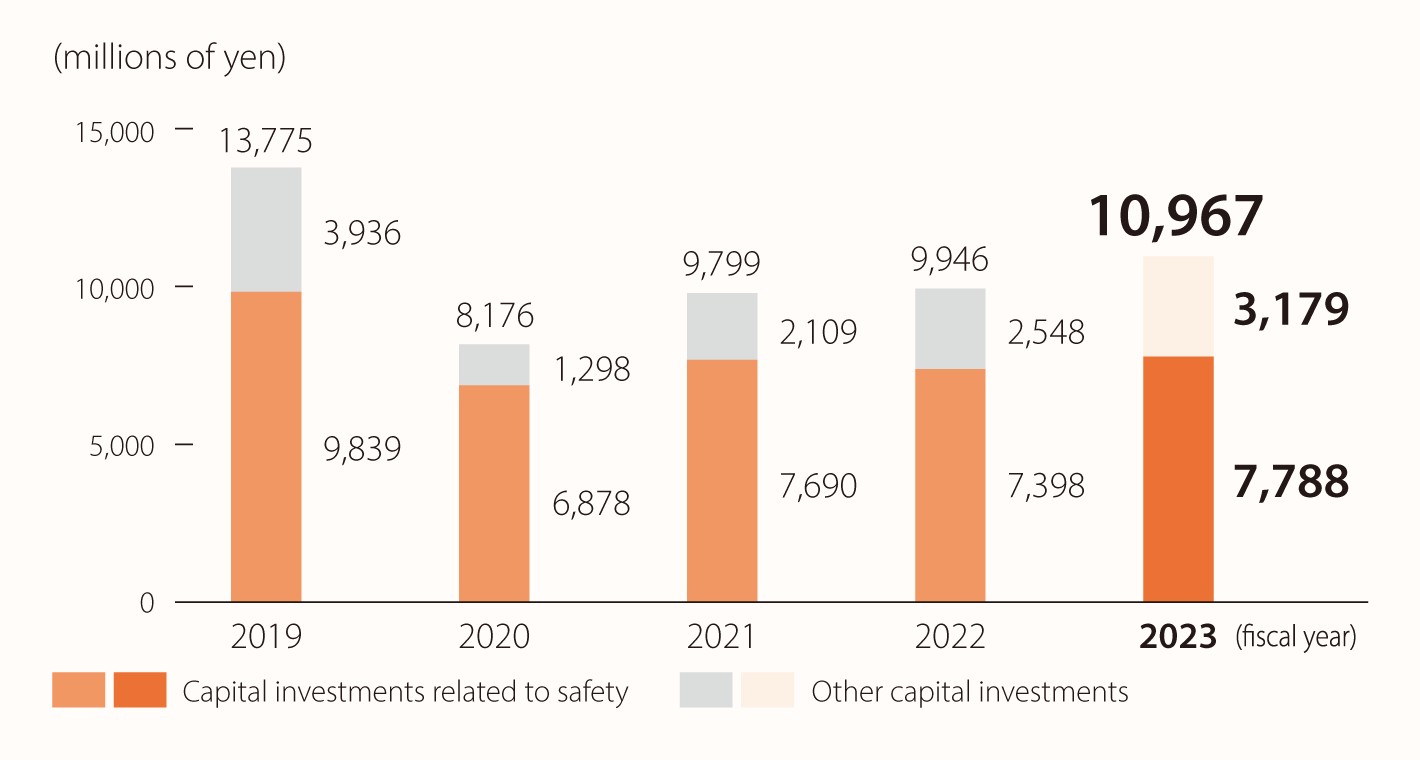
Status of railway operation accidents, transportation failures, and incidents
Occurrence, administrative guidance, etc. in FY2023
There were no major accidents. However, there were two incidents: a railroad crossing failure accident*2 and an incident (cracks in bogie frames in the factory).
*1 Incidents in the railway business, transportation failures (limited to delays or suspensions in service for at least three hours), and other incidents for which we are responsible.
*2 Reported to the Kinki District Transport Bureau; no administrative guidance was issued to our company.
Occurrences in the past five years
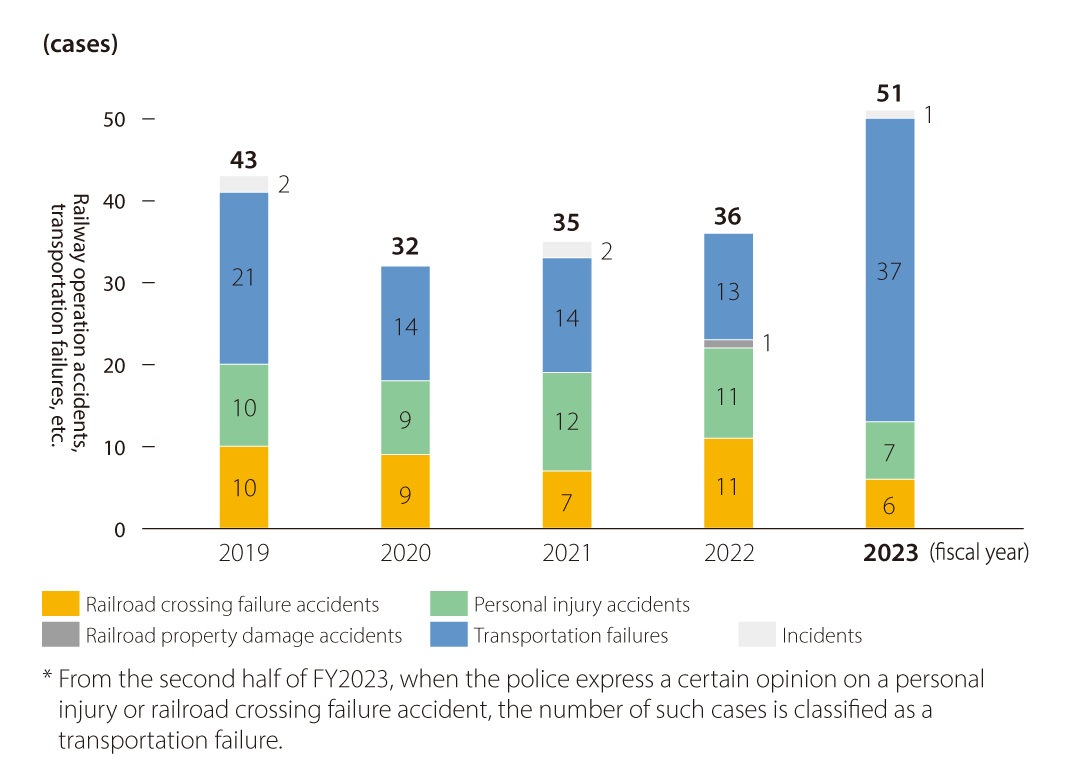
<Reference> Classification of railroad operation accidents, etc.
| Railroad operation accidents | Major accidents | Train collision accidents | Accidents where a train collided with or came into |
| Train derailment accidents | Accidents where a train was derailed | ||
| Train fire accidents | Accidents involving fires on trains | ||
| Railroad crossing failure accidents | Accidents where a train or vehicle collided with or came | ||
| Personal injury accidents | Accidents that resulted in the death or injury of a person | ||
| Railroad property damage accidents | Accidents resulting in property damage of ¥5,000,000 or | ||
| Transportation failures | A situation in which trains are suspended or delayed (for | ||
| Incidents | A situation that has not caused an accident yet, but is | ||
Conducted Safety education
Comprehensive training for accident recovery
Every year, "comprehensive training for accident recovery" is conducted in which all departments participate to rescue injured customers, evacuate customers, and restore areas that have been damaged, based on a scenario of a large-scale accident or disaster. In FY2023, the training took place based on the scenario of "guiding customers from train cars to the nearest train station and restoring damaged facilities for a train that had stopped under the instructions of the Earthquake Early Warning System and had derailed due to the shaking of the earthquake." In addition, employees from divisions other than the railway division also participated in the evacuation drill and confirmed the procedures for guiding customers in an emergency.
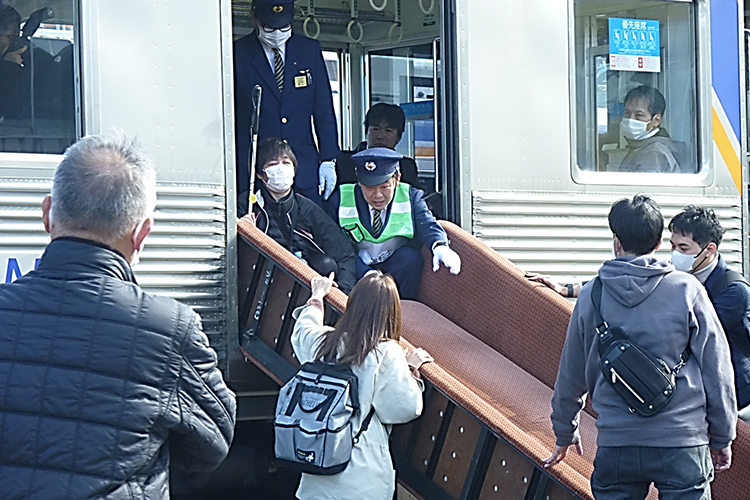
Joint training conducted with the police, etc., to be prepared for railway terrorism
Following an incident involving an onboard injury that occurred on the JR Kansai Airport Line between Hineno Station and Rinku Town Station in FY2023, we conducted liaison reporting, evacuation guidance, and criminal suppression training with the aim of strengthening cooperation with the police along our railway lines.
We also conducted training on what to do in the event of an emergency on the train, including checking how to operate the train when the emergency button is pressed, how to press the emergency button, and how to handle the door release cock.
Related Links
Sustainability Site Map
(materiality)
- Major sustainability themes (materiality)
- Identification processes
- Further seek safety, security, and satisfaction
- Thriving and friendly community development
- Create a future full of dreams
- Achieve an enriched life
- Develop a workplace and staff in a way that enables each person to put their abilities to use
-
Contribute to preserving the global environment
- Environmental philosophy
- Reducing CO2 emissions in response to climate change, promoting the use of renewable energy, and so forth
- Bringing about a circular society
- Preserving biodiversity
- Deepening our environmental management
- Expanding environmental buildings (green buildings)
- Responses to TCFD Recommendations
- Bolster a corporate foundation that is sincere and fair
